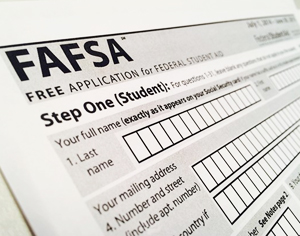 By Alecia Taylor
By Alecia Taylor
Howard University News Service
Students and parents may be wondering why this year’s October went by like a breeze: no fussing, fighting or trying to find that piece of paper with the parental login for the Free Application Federal Student Student Aid form (FAFSA).
Usually, FAFSA opens at midnight on Oct. 1 each year, but this year it opened on Dec. 31 and will close June 30, 2024. However, the opening of the application is not the only change. Families should expect a significant decrease in questions, new language on the form and possibly larger grants for some students.
Instead of 108 questions, families will only have to fill out 36 questions. In addition, the IRS will directly import federal tax information, with the user’s consent, instead of applicants having to enter it manually.
“We found the FAFSA is not just a hassle that people dread filling out but it’s also so complicated that it’s a meaningful obstacle to people getting help to go to college,” said James Kvaal, the Under Secretary at the Department of Education.
Kvaal said the goal is to make sure that the financial aid system is effective at giving people access to college degrees.
With the form’s new makeover, more than 600,000 additional students will become eligible for Pell Grants.
“Our hope is to reach Black students and help them understand the resources that are available and that, you know, college may be more affordable than you think,” the Under Secretary said.
Over 70% of Black students receive loans compared to 56% of their white counterparts, according to the National Center for Higher Education. Black students were also the highest demographic to rely on Pell Grants, with Hispanic students following close behind.
The extra Pell Grant money comes from Congress and is included in the overall federal budget. Kvaal said President Biden thinks this is “one of the best investments” the country could make and hopes to double the Pell Grant by 2029 if elected for a second term.
While there are certainly behind-the-scenes changes to FAFSA, families can expect other changes when filling out the form.
The Expected Family Contribution, commonly known as an EFC score, is being replaced with the Student Aid Index (SAI). Like the EFC score, the SAI will determine a student’s ability to pay for college. With the EFC score, the minimum contribution was zero, while the new SAI’s minimum is -1,500.
For first-time families – or those who may be a little rusty – filling out the form, the U.S. Department of Education has been rolling out a series of training to ensure schools, educators and nonprofits have the tools to help families navigate the new form.
Cait Belney, D,C. Public Schools Manager of the College Alumni Support program said the Department of Education made sure staff members are trained to answer any questions families may have for this upcoming FAFSA season.
Back in August, DCPS and other school districts, colleges, universities and libraries attended a national training on navigating the new form. The training was co-hosted by the Federal Student Aid and the National College Team.
“[Federal Student Aid is] working really hard to connect with state higher education agencies, college access and public school systems,” Belney said. “I do think they’re doing their best while also trying to rebuild from scratch an entire system.”
Educators may have gotten the memo for the new changes, but some parents aren’t confident in the Department of Education’s communication about FAFSA.
“I’m not sure that the Department of Education has done the best job of being inclusive in their approaches,” said Tameika Pope, a parent of two undergraduate students at historically Black colleges. “I see room for improvement on that.”
The changes may seem sudden to some, but Pope noticed small changes dating back to 2020, which made her search for more information about upcoming changes for the 2022-23 and 2023-24 application.
This cycle’s changes are a direct result of the FAFSA Simplification Act. However, modification started in the 2021-22 application with the removal of limitations on those enlisted in the military as well as removing questions about drug convictions and the restoration of Pell Grants for incarcerated individuals.
Now, questions that Kvaal called “obscure” will be eliminated to ensure more students have access to grants, according to the Department of Education.
Pope said she’s gotten the majority of her information from the announcement section of Federal Student Aid site. Still, she worries that people who are not tech-savvy are missing out on useful information about the changes.
Kvaal said Federal Student Aid is working with educators and nonprofits to get the word out.
“We have one of the most diverse systems of higher education in the world, and there are a lot of choices for young people,” he said. “We have resources available to help them consider their college options and make informed decisions.”
As of right now, this year is the only exception for a delayed opening of the applications. Students and parents can expect the application to open on its usual Oct. 1 date in 2024.
Alecia Taylor is an education reporter for HUNewsService.com and a Spring Intern for the Chronicle of Higher Education.
